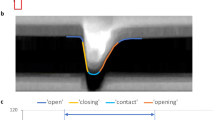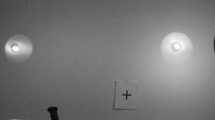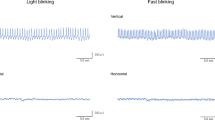Abstract
Background
In order to measure blinking, we developped a dynamic device consisting of a CCD camera connected to a videonystagmography machine. We developed an artificial pupil that allowed the camera to track movements of the upper eyelid.
Methods
Blinking parameters were measured in eight healthy volunteers, studying spontaneous blinking (SB) and voluntary blinking (VB) responses. Closing time, opening time, closing speed, vertical amplitude, horizontal amplitude and frequency of spontaneous blinking were recorded.
Results
In SB, opening time (0.21 ± 0.04 s) was significantly longer than closing time (0.10 ± 0.02 s) (p < 0.0001). Mean closing speed was 87 ± 26 m/s in SB and 168 ± 59 m/s in VB. Mean vertical amplitude was 9.1 ± 2.2 mm. Mean vertical amplitude was lower in SB (9.1 ± 2.2 mm) than in VB (12.3 ± 1.9 mm) (p < 0.001). Mean horizontal amplitude was also lower in SB (2.7 ± 0.9 mm) than in VB (3.8 ± 0.9 mm) (p < 0.05). Frequency of SB was 18.4 ± 3.4 per minute.
Conclusions
Computer-assisted video acquisition provides real-time measurement of eyeblink dynamics. On healthy volunteers, this method enables accurate measurement of opening and closing responses as well as associated horizontal movement, and enables differentiating spontaneous and voluntary blinking.




Similar content being viewed by others
References
Abelson MB, Holly FJ (1977) A tentative mechanism for inferior punctate keratopathy. Am J Ophthalmol 83:866–869
Becker W, Fuchs AF (1988) Lid-eye coordination during vertical gaze changes in man and monkey. J Neurophysiol 60:1227–1252
Björk A, Kugelberg E (1953) The electrical activity of muscles of the eye and eyelids in variouspositions and during movements. Electroencephalogr Clin Neurophysiol Suppl 5:595–602
Choi SH, Park KS, Sung MW, Kim KH (2003) Dynamic and quantitative evaluation of eyelid motion using image analysis. Med Biol Eng Comput 41:146–150
Doane MG (1980) Interactions of eyelids and tears in corneal wetting and the dynamics of the normal human eyeblink. Am J Ophthalmol 89:507–516
Evinger C, Manning KA, Sibony PA (1991) Eyelid movements. Mechanisms and normal data. Invest Ophthalmol Vis Sci 32:387–400
Georges JL (1998) Physiologie des paupières. In: Adenis JP, Morax S (eds) Pathologie orbito-palpébrale. Masson, Issy Les Moulineaux, pp 22–30
Guitton D, Simard R (1991) Upper eye lid movements measured with the search coil in magnetic field technique during blinks and vertical saccades. Invest Ophthalmol Vis Sci 32:3298–3305
Holder DS, Scott A, Hannaford B, Stark L (1987) High resolution electromyogram of the human eyeblink. Electromyogr Clin Neurophysiol 27:481–488
Holly FJ, Lemp MA (1977) Tear physiology and dry eyes. Surv Ophthalmol 22:69–87
Hung G, Hsu F, Stark L (1977) Dynamics of the human eyeblink. Am J Optom Physiol Opt 54:678–690
Linstrom CJ, Silverman CA, Susman WM (2000) Facial-motion analysis with a video and computer system: a preliminary report. Am J Otol 21:123–129
McDonald JF, Brubaker S (1971) Meniscous induced thining of tear films. Am J Ophthalmol 72:139–146
Nakamori K, Odawara M, Nakajima T, Mizutani T, Tsubota K (1997) Blinking is controlled primarily by ocular surface conditions. Am J Ophthalmol 124:24–30
Niida T, Mukono K, Ishikawa S (1987) Quantitative measurement of upper eyelid movements. Jpn J Ophthalmol 31:255–264
Somia NN, Rash GS, Epstein EE, Wachowiak M, Sundine MJ, Stremel RW, Barker JH, Gossman D (2000) A computer analysis of reflex eyelid motion in normal subjects and in facial neuropathy. Clin Biomech 15:766–771
Sun WS, Baker RS, Chuke JC, Rouholiman BR, Hasan SA, Gaza W, Stava MW, Porter JD (1997) Age-related changes in human blinks. Passive and active changes in eyelid kinematics. Invest Ophthalmol Vis Sci 38:92–99
Tsubota K, Hata S, Okusawa Y, Egami F, Ohtsuki T, Nakamori K (1996) Quantitative videographic analysis of blinking in normal subjects and patients with dry eye. Arch Ophthalmol 114:715–720
VanderWerf F, Brassinga P, Reits D, Aramideh M, Ongerboer de Visser B (2003) Eyelid movements: behavioral studies of blinking in humans under different stimulus conditions. J Neurophysiol 89:2784–2796
Acknowledgements
AMADYS, Le Gorvello, 56250 Sulniac, France, for its financial support; Benoît Marin, Unité Fonctionnelle en Recherche Clinique et Biostatistiques, Limoges Medical University, for his technical assistance.
Author information
Authors and Affiliations
Corresponding author
Additional information
No author has any type of financial interest that is related to the manuscript, including stock or ownership of a business entity connected to a product described in the paper, paid consulting for the company or competing companies, or patent rights to a drug or piece of equipment. No author has neither personal nor family ownership or potential rights to more than 1% of the company or competing company nor any interest in marketing any product, drug, instrument, or piece of equipment discussed in the manuscript. The authors have full control of all primary data, and they agree to allow Graefe’s Archive for Clinical and Experimental Ophthalmology to review their data if requested.
Financial support: AMADYS (Association des Malades Atteints de Dystonie), Le Gorvello, 56250 Sulniac, France.
Rights and permissions
About this article
Cite this article
Casse, G., Sauvage, JP., Adenis, JP. et al. Videonystagmography to assess blinking. Graefes Arch Clin Exp Ophthalmol 245, 1789–1796 (2007). https://doi.org/10.1007/s00417-007-0611-8
Received:
Revised:
Accepted:
Published:
Issue Date:
DOI: https://doi.org/10.1007/s00417-007-0611-8




